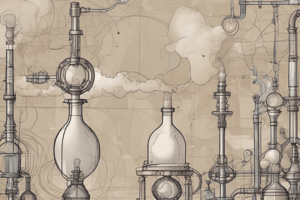Podcast
Questions and Answers
What is the unit of temperature that must be used for all gas laws?
What is the unit of temperature that must be used for all gas laws?
- Fahrenheit
- Kelvin (correct)
- Rankine
- Celsius
What is the relation between pressure and volume according to Boyle's Law?
What is the relation between pressure and volume according to Boyle's Law?
- Indirectly proportional
- Not related
- Directly proportional
- Inversely proportional (correct)
Which gas law compares pressure, volume, moles, and temperature?
Which gas law compares pressure, volume, moles, and temperature?
- Charles' Law
- Combined Gas Law
- Ideal Gas Law (correct)
- Avogadro's Law
What is the conversion factor from Celsius to Kelvin?
What is the conversion factor from Celsius to Kelvin?
What is the first step in solving a gas law problem?
What is the first step in solving a gas law problem?
What is the unit of pressure equivalent to 1 atmosphere?
What is the unit of pressure equivalent to 1 atmosphere?
Flashcards are hidden until you start studying
Study Notes
Here is the summary of the text in detailed bullet points:
• The video focuses on gas laws and how to choose the correct formula to use in different scenarios.
• Temperature units must be in Kelvin for all gas laws; to convert Celsius to Kelvin, add 273.
• Pressure units can be in atmospheres, Torr, or millimeters mercury; 1 atmosphere = 760 Torr = 760 millimeters mercury.
• The main gas laws to know are: + Boyle's Law: compares pressure and volume + Charles' Law: compares volume and temperature + Avogadro's Law: compares volume and moles + Combined Gas Law: compares pressure, volume, and temperature + Ideal Gas Law: compares pressure, volume, moles, and temperature
• To solve a problem, identify the given information and what is being asked to find, and then choose the correct formula based on the variables given.
• When working with units, make sure to convert to the correct units if necessary, and cancel out units that appear in both the numerator and denominator.
• Examples of problems solved in the video include: + Finding the new volume of a sample of nitrogen gas warmed from 77°C to 86°C, with pressure held constant. + Finding the pressure required to compress a volume of air from 196 liters to 26 liters, with temperature held constant. + Finding the volume of a gas balloon at a new temperature and pressure, using the combined gas law. + Finding the volume of a gas using the ideal gas law, given the number of moles, temperature, and pressure.- The goal is to isolate volume by dividing both sides of the equation by atmospheres, which cancels out atmospheres and leaves liters.
- The calculation yields a volume of 39.408 liters.
- The number of significant figures (sig figs) to round to is determined by the lowest amount in the multiplication and division, which is 1.
- Rounding up, the final answer is approximately 40 liters.
- The importance of remembering gas laws, including this calculation, is emphasized.
Studying That Suits You
Use AI to generate personalized quizzes and flashcards to suit your learning preferences.



